Description
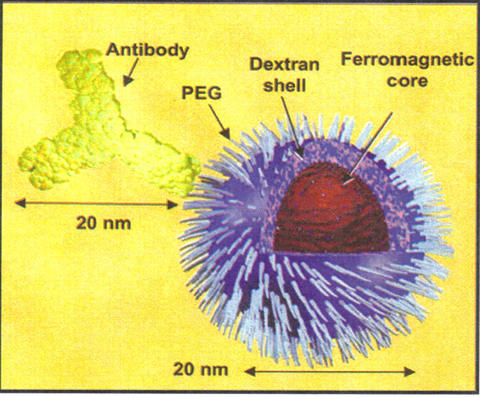
Our aim is to develop the metrology for control and manipulation of magnetic anisotropy in magnetic materials. This includes development of the measurement science for quantification of the magnetic properties (e.g., magnetic anisotropy, magnetic exchange) and the structure-property-processing relationships underpinning the materials science.
Major Accomplishments
Existence of “Colloidal” Magnetic Anisotropy in Magnetic Nanoparticle Dispersions
We observe a magnetic behavior in magnetic nanoparticle dispersions which is distinct from the cubic magnetocrystalline anisotropy of the magnetic material (Fe3O4). Instead, this distinct behavior has its origins in the magnetic interactions among the mobile nanoparticles within the colloid.
Specifically, we observed that the onset of a field-dependent colloidal uniaxial anisotropy coincides with chain formation parallel to the direction of the external magnetic field. At even higher fields, the onset of colloidal unidirectional and trigonal anisotropies occurs simultaneously with chain compression into columns and chain zippering (for close packing) perpendicular to the field direction. These anisotropies are distinct from the cubic magnetocrystalline anisotropy measured for bulk Fe3O4 because (a) there is no uniaxial, unidirectional, or trigonal anisotropy present in bulk magnetite; and (b) the measured colloidal uniaxial anisotropy is approximately 100-fold greater than the measured magnetocrystalline cubic anisotropy, which is approximately 4% that of the bulk value for magnetite. These observations suggest that field-induced changes of the physical structure of dilute magnetic colloids can lead to dramatic changes in their composite magnetic properties, presumably arising from competing magnetostatic and steric interactions. The results can be used to guide further development of models useful in many applications that utilize static and alternating magnetic fields, such as magnetic particle imaging, hyperthermia, in vitro assays, and shock absorption. Insights gained also provide new understanding to identify fundamental magnetic origins of the seemingly contradictory findings that magnetic nanoparticles in FFs exhibit anomalously large and small magnetocrystalline anisotropies, as compared to the bulk value, as well as unique magneto-physical properties, such as the asymmetric sound propagation observed in concentrated MR fluids, and the overestimation of the transverse magnetization in rotating MR colloids.
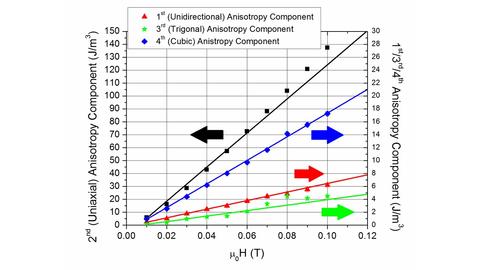
[C.L. Dennis, A.J. Jackson, J.A. Borchers, C. Gruettner, and R. Ivkov, “Correlation Between Physical Structure and Magnetic Anisotropy in a Magnetic Nanoparticle Colloid”, Nanotechnology, 29 (2018) 215705.]
Physical Properties Impacting Heat Generation in Magnetic Nanoparticle Dispersions
Insufficient characterization of bulk and microscopic properties (static and dynamic) of magnetic colloids has inhibited progress toward an understanding of these complex systems. This issue is particularly evident for in vivo medical applications which place high demands on material performance, such as heat generation (specific loss power or SLP) measurements for the cancer treatment hyperthermia. To address this issue, we have investigated the variations in measured values of the SLP (as a function of alternating magnetic field amplitude) exhibited by nanoparticles demonstrating similar bulk magnetic and structural characteristics. We found that a combination of intercore dipole interactions as well as variations in the internal magnetic (intracore) structure can account for these differences. Our results suggest a renewed examination of models and characterization methods is needed to advance magnetic colloids for various applications.
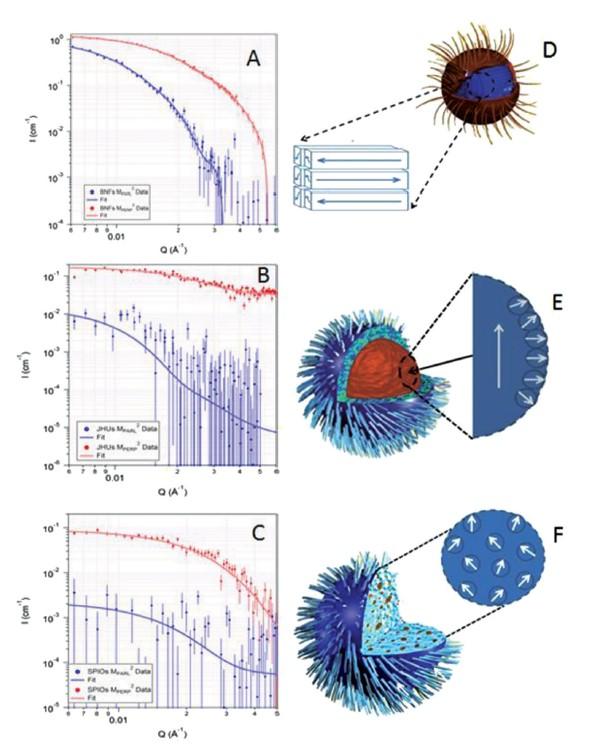
[C.L. Dennis, K.L. Krycka, J.A. Borchers, R.D. Desautels, J. van Lierop, N.F. Huls, A.J. Jackson, C. Grüttner, and R. Ivkov, “Internal magnetic structure of nanoparticles dominates time-dependent relaxation processes in a magnetic field”, Advanced Functional Materials, 25 (2015) 4300-4311.]
Measurement Reproducibility
For metrology, measurement reproducibility is critical. We studied the reproducibility of measurements on a second-order gradiometer superconducting quantum interference device magnetometer of two different yttrium iron garnet (YIG) spheres, both having a diameter of 1 mm: 1) the National Institute of Standards and Technology magnetic moment standard reference material (SRM) and 2) a commercial sample. When the magnetic moment of the SRM was repeatedly measured as a function of rotation angle φ from 0° to 360°, we observed a sinusoidal variation in the measured values. The radial offset dependence of the observed magnetic moment was experimentally confirmed by the measurements of the commercial sphere placed in a hole in several cylindrical containers, wherein the distance between the center of the hole and the center of the container was r. The r-dependence of the minimum from each φ-dependent measurement series is qualitatively consistent with the theoretical curve. When the φ-dependent measurements for the SRM in a capsule were repeated 12× over 21 months, the relative standard deviation of the minimums improved up to 0.1%. Knowledge of these facts will be necessary for the accurate measurement of the magnetic moment of other sample forms (e.g., powders).
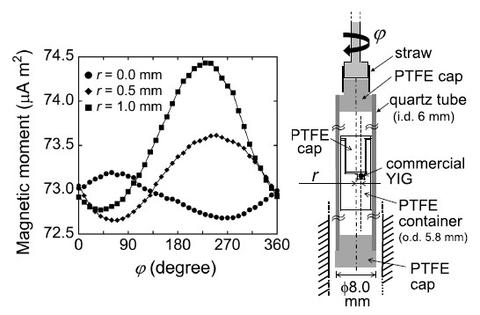
[N. Matsumoto, C.L. Dennis, and R.D. Shull, “Improvement of Reproducibility of Magnetic Moment Detected by a SQUID Magnetometer Through Radial Offset Measurement on a YIG Sphere”, IEEE Transactions on Magnetics, 55 (2019) 9400305.]
Influence of Grain Constraint on the Magneto-Caloric Effect
We demonstrated that increasing the grain size to thickness ratio of Ni45Mn40Co5Sn10 ribbon samples by annealing heat treatments can decrease the magnetic field requirement for magnetic refrigeration by as much as 3 T under the annealing conditions studied. It is expected that the magnitude of field savings can be even larger with further grain growth. The average grain size increased with annealing time and temperature, which decreased the martensite transition temperature range due to reduction in the density of interfaces. The temperature transition range for the austenite, on the other hand, did not exhibit a significant trend. This improved the refrigeration capabilities of the Ni45Mn40Co5Sn10 by making the structural transformation between paramagnetic austenite and non-magnetic martensite more attainable with smaller fields. This decrease in the field requirement ultimately led to a larger magnetocaloric entropy change achieved under relatively smaller magnetic field levels. The giant inverse magnetocaloric effect of the optimized alloy was measured and showed that up to 25 J/(kg-K) was generated by driving the martensitic transition with magnetic fields up to 7 T.
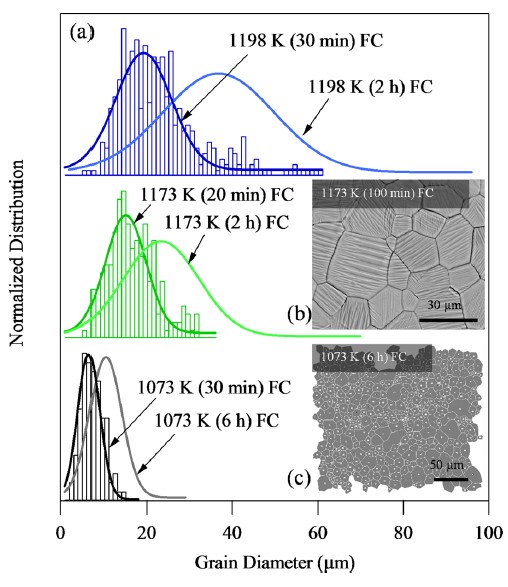
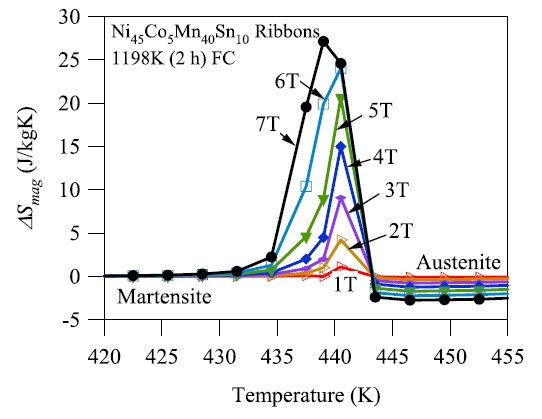
[N.M. Bruno, I. Karaman, J.H. Ross Jr., Y.J. Huang, J.G. Li, Y.I. Chumlyakov, C.L. Dennis, and R.D. Shull, “Effect of Grain Restraint on the Field Requirements for Magnetocaloric Effect in Ni45Co5Mn40Sn10 Melt-Spun Ribbons,” Journal of Applied Physics, 120 (2016) 075101.]
First Order Reversal Curve Analysis of Magnetic Tunnel Junctions
We have applied a new method for First Order Reversal Curve (FORC) analysis that is particularly well suited for the study of unpatterned films, because it does not require smoothing in field and therefore can resolve the very sharp structures due to domain wall motion that are typically seen in the FORC diagrams of unpatterned films. It also allows us to visualize the reversible and irreversible parts of the system together, without making an artificial distinction between reversible and low-coercivity materials.
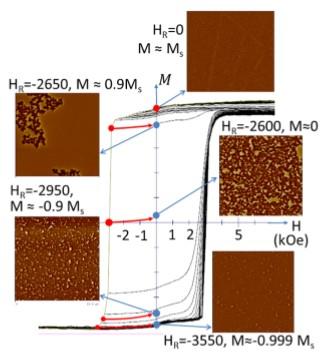
[J.B. Abugri, P.B. Visscher, S. Gupta, P.J. Chen, and R.D. Shull, “FORC Plus Analysis of Perpendicular Magnetic Tunnel Junctions,” Journal of Applied Physics, 126 (2019) 013901.]
Development of Good Soft Magnetic and High Strength Materials
With the aim of developing a new Fe-based alloy with good soft magnetic properties and/or ultrahigh strength, we examined the formation ability, thermal stability and properties of an amorphous phase in melt-spun Fe-rich Fe82-85B13-16Si1Cu1 alloys. The results obtained are summarized as follows:
- An amorphous phase was formed in the low B content range of 13–16 %B and high B/Si content ratios above 13. The addition of 1%Cu was found to be essential for the formation of the 13B amorphous alloy, while no amorphous phase was formed for alloy 13B containing 1%Nb.
- Good soft magnetic properties were obtained in both the annealed amorphous state as well as in the nanoscale α-Fe+amorphous mixed state.
- The Vickers hardness value is 867 for alloy 13B and decreases to 803 for alloy 16B. Vickers hardness increases significantly during the phase change to α-Fe+amorphous phases and reaches 1370–1550 after annealing.
- The highest Vickers hardness for the Fe-B-Si-based amorphous alloys without Cu is about 1200 and the addition of 1%Cu was also found to be essential for the achievement of the ultrahigh hardness values.
The findings that the Fe-B-Si-Cu alloys exhibit good soft magnetic properties in both the annealed amorphous and amorphous + α-Fe phases as well as ultrahigh Vickers hardness values exceeding 1550 in the α-Fe+amorphous phase material are promising for further extension as improved soft magnetic and high strength materials having a simpler Fe-rich alloy composition.
[L.L. Pang, A. Inoue, E.N. Zanaeva, F. Wang, A.I. Bazlov, Y. Han, F.L. Kong, S.L. Zhu, and R.D. Shull, “Nanocrystallization, Good Soft Magnetic Properties and Ultrahigh Mechanical Strength for Fe82-85B13-16Si1Cu1 Amorphous Alloys,” Journal of Alloys and Compounds, 785 (2019) 25.]
Voltage Controlled Magnetism
An ultimate goal of spintronics is to control magnetism via electrical means. One promising way is to utilize a current-induced spin-orbit torque (SOT) originating from the strong spin-orbit coupling in heavy metals and their interfaces to switch a single perpendicularly magnetized ferromagnetic layer at room temperature. However, experimental realization of SOT switching to date requires an additional in-plane magnetic field, or other more complex measures, thus severely limiting its prospects. We demonstrate a novel structure consisting of two heavy metals (Pt/W/CoFeB/MgO and similar structures) that delivers competing spin currents of opposite spin indices. Instead of just canceling the pure spin current and the associated SOTs as one expects and corroborated by the widely accepted SOTs, such devices manifest the ability to switch the perpendicular CoFeB magnetization solely with an in-plane current without any magnetic field. Magnetic domain imaging reveals selective asymmetrical domain wall motion under a current. This discovery paves the way for the application of SOT in nonvolatile technologies, but also poses questions on the underlying mechanism of the commonly believed SOT-induced switching phenomenon.
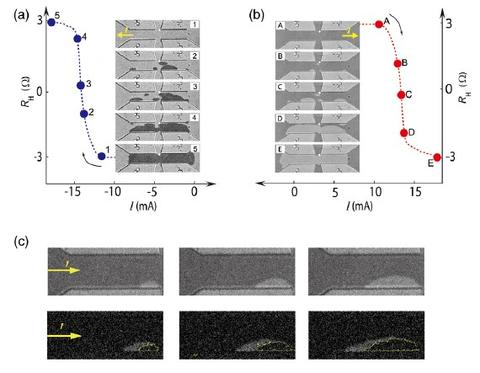
[Qinli Ma, Yufan Li, D.B. Gopman, Yu.P. Kabanov, R.D. Shull, and C.L. Chien, “Switching a Perpendicular Ferromagnetic Layer by Competing Spin Currents,” Physical Review Letters, 120 (2018) 117703.]
SRM 772a Magnetic Moment Standard - Nickel Sphere
SRM 762 Magnetic Moment Standard - Nickel Disk
SRM 764a - Magnetic Susceptibility Standard - Platinum Cylinder
SRM 2853a - Magnetic Moment Standard - Yttrium Iron Garnet Sphere (forthcoming)

